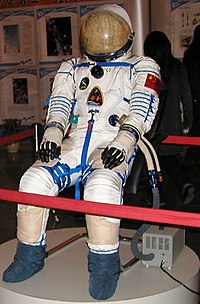Sokol space suit
Some of the early Soyuz flights carried Yastreb space suits but these were only for spacewalks and were only worn in orbit.
One of the recommendations of the investigating government commission was that pressure suits should be worn by future crews during critical phases of their mission—launch, docking and landing.
A mirror on an elastic wrist band is worn on the right, to help the wearer see beyond the suit's limited field of view.
Sokol is often worn with a wristwatch, with an elastic band replacing the strap to allow it to fit over the bulky suit glove.The watches are often privately purchased, and a wide variety of Swiss and Russian models have been used.
Normally, an electric blower ventilates the suit with cabin air through the larger hose at the rate of 150 litres (5.3 cubic feet) per minute.
This has the advantage of simplicity; the disadvantage of a high rate of oxygen consumption is considered acceptable given that it is only intended for emergency use.
They can also float and have a neck dam that allows the visor to be raised in water without the risk of flooding the suit.
When the suit is on, an airtight seal is made by tightly rolling up the appendix and securing it with strong elastic bands.
Grey leather outer boots are also worn on the ground; they protect the feet of the suit from damage and are removed before entering the spacecraft to avoid carrying debris into the cabin.
The suit is worn during launch and re-entry of the Soyuz spacecraft—the gloves are attached and the visor is sealed at these times.
If more than limited movement is required, the pressure relief valve may be adjusted to a lower setting of 270 hPa (0.26 atm, 3.9 psi).
However, this feature was discarded in the Sokol-KV2 and the appendix was retained as a means of donning the suit—it was thought to be more reliable than the airtight zippers the Russians were able to make.
The KM and KV also featured a liquid-cooled undergarment that would increase the comfort of the wearer by efficiently removing body-heat; other suits relied on the flow of air to do this.
The improved arms, legs, and gloves of the Sokol-KV were retained although the liquid cooled undergarment of the KM and KV was discarded.
It was planned that the crew of the British QinetiQ 1 high-altitude balloon would wear modified Sokol suits purchased from Zvezda.
As the balloonists would have occupied an open platform during their twelve-hour flight, the Sokol suits, together with heavily insulated outer garments, would have protected them from the cold and low pressure of the stratosphere as the balloon ascended to a height of around 40 km (130,000 ft).





